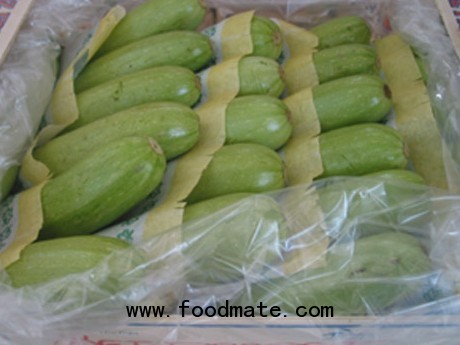Harvesting
As for other crops, the following considerations should be made during harvesting:
- Harvest as early as possible in the day to avoid exposure to high temperatures
- Field crates should be frequently washed and disinfected to avoid cross contamination.
- Try to avoid any contact between the crates and the soil.
- Use harvesting crates that are light in color to reduce absorption of heat.
- Fill the crates to no more than 75% of their capacity, in order to ensure adequate air flow between the crates and avoid mechanical damage.
- Avoid exposure of the harvested squash to direct radiation from the sun by placing an empty crate on top of each stack and storing in a shaded area. Note that heat increases the rate of respiration, which is already relatively high after harvest.
- The harvested squash should be moved as soon as possible to the packing house (Delayed postharvest cooling and exposure to the sun leads to accelerated quality deterioration).
Postharvest Storage
Squash should be precooled promptly after harvest to remove field heat, reduce weight loss and extend storage life. Room air, forced air or hydrocooling should be used. The latter method is popular amongst StePac’s customers, because not only is it an efficient cooling method but it provides an opportunity to prewash and thereby remove mud, dust and inactivate pathogenic microorganisms.

Summer squash are quite perishable and highly susceptible to chilling injury. The skin is tender and easily damaged during handling. Under recommended storage conditions of 5-10 degreesC and 95% RH, the storage life is typically only 1-2 weeks. Storage below 5oC for more than 3-4 days results in chilling injury, which manifests itself as surface pitting and discoloration, followed by decay that becomes more evident when the squash are transferred to higher temperatures. The tender skin makes the fruits very susceptible to water loss and shriveling. Senescence symptoms include color change, softening of the flesh and increased susceptibility to decay, especially when there is mechanical damage or the produce has previously been stored at chilling temperatures.
Modified atmosphere packaging and storage
It has been found that a combination of appropriate levels of CO2 with the reduced humidity and condensation in Xtend modified atmosphere/modified humidity packaging enables freshness and quality to be maintained for up to 21 days, which is beyond the typical storage life of 10-14 days.
Use of polyethylene modified atmosphere packaging is likely to aggravate decay due to the low moisture vapor transmission rate (MVTR) and the high relative humidity in the packaging at steady state.
Packing in Xtend
Ideally, squash should be cooled before packing and sealing in Xtend MAP, but in cases were produce temperature is not higher than ~15°C and efficient forced air cooling is available, the squash can be cooled through the sealed packaging after packing.
Performance
- Reduces weight loss
- Reduces decay
- Preserves freshness and slows quality deterioration
Shelf life Typical Storability
3 days at 20°C (68°F) 21 days at 8°C (46°F) Squash






